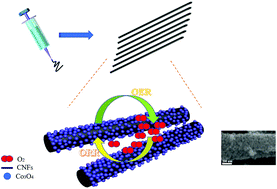Co3O4 nanoparticles supported on N-doped electrospinning carbon nanofibers as an efficient and bifunctional oxygen electrocatalyst for rechargeable Zn–air batteries†
Abstract
Composite materials made up of non-precious metal oxide and N-doped carbon materials are great potential bifunctional catalysts for Zn–air batteries (ZABs) owing to the synergistic effect caused by the two components. Herein, Co3O4 nanoparticles supported on N-doped electrospun carbon nanofibers (CNFs) with superior bifunctional activity for the ORR/OER and remarkable electrocatalytic stability in an alkaline electrolyte are designed and synthesized. In addition, the hybrid electrocatalyst further promotes the rechargeable ZABs with a low overpotential, high efficiency and prolonged cycling life, superior to those using precious metal catalysts of Pt/C and IrO2. Such a remarkable bifunctional catalytic activity is attributed to the enhanced charge transfer capability, abundant exposed catalytically active sites and the synergistic effect among the Co3O4 nanoparticles and CNFs. This work should provide a convenient pathway for the design of non-precious metal and carbon hybrid materials that can be employed as efficient electrocatalysts for large-scale implementations of renewable energy conversion devices.



 Please wait while we load your content...
Please wait while we load your content...